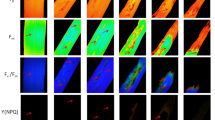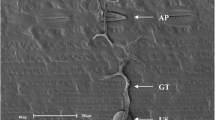Abstract
Interactions between different barley genotypes and the fungal pathogen Blumeria graminis f.sp. hordei (Bgh) have a specific impact on the crop physiology. Within the context of plant resistance phenotyping, it is relevant to investigate early host–pathogen interactions to avoid the crop infestation. Analyzing different parameters of the photosynthesis apparatus gives in-depth information of the plant’s health status and can be used for a spatial and temporal assessment of interaction types during plant–pathogen infestation. In the present study, experiments were performed with a near-isogenic line of barley cv. Ingrid WT (susceptible), mlo3 (papilla-based resistance) as well as a near-isogenic line of cv. Pallas, containing the Mla1 (hypersensitive response-based resistance) gene. After inoculation with Bgh isolate K1, the leaves were measured daily using chlorophyll fluorescence imaging. Inoculated, susceptible wild-type leaves showed a reduced effective quantum yield of the photosystem II (ΦPSII) already 1 day after inoculation. In accordance with the quantum yield reduction, the non-photochemical quenching (NPQ) increased, indicating thermal dissipation of excess energy. The changes of ΦPSII and NPQ represent modifications of the leaf metabolism to aid the fungal nutrition uptake, which is influenced by Bgh. By analyzing these parameters, it was also possible to indicate resistance reactions of mlo3 and Mla1 barley genotypes against Bgh. During papilla formation in mlo3 leaves, ΦPSII revealed the lowest values. In contrast, inoculated Mla1 leaves showed the lowest NPQ. The present study proofs that chlorophyll fluorescence imaging is a valuable tool for investigating early plant–pathogen interaction noninvasively. Furthermore, this phytopathology study uses chlorophyll fluorescence imaging, chlorophyll extraction and microscopic observations to characterize the interaction response of different genotypes to an Bgh infection.



Similar content being viewed by others
References
Arnon DI (1949) Copper enzymes in isolated chloroplasts. Polyphenoloxidase in Beta vulgaris. Plant Physiol 24:1–15
Baker NR (2008) Chlorophyll Fluorescence: a probe of photosynthesis in vivo. Annu Rev Plant Biol 59:89–113
Baker NR, Oxborough K (2004) Chlorophyll fluorescence as a probe of photosynthetic productivity. In: Papageorgiou GC, Govindjee G (eds) Chlorophyll a fluorescence—a signature of photosynthesis. Springer, Dordrecht, pp 66–79
Bassanezi RB, Amorim L, Berger RD (2002) Gas exchange and emission of chlorophyll fluorescence during the monocycle of rust, angular leaf spot and anthracnose on bean leaves as a function of their characteristics. Phytopathology 150:37–47
Berger S, Benediktyová Z, Matous K, Bonfig K, Mueller MJ, Nebald L, Roitsch T (2006) Visualization of dynamics of plant-pathogen interaction by novel combination of chlorophyll fluorescence imaging and statistical analysis: differential effects of virulent and avirulent strains of P. syringae and of oxylipins A. thaliana. J Exp Bot 58:797–806
Both M, Csukai M, Stumpf MP, Spanu PD (2005) Gene expression profiles of Blumeria graminis indicate dynamic changes to primary metabolism during development of an obligate biotrophic pathogens. Plant Cell 17:2107–2122
Büschges R, Hollricher K, Panstruga R, Simons G, Wolter M, Frijters A, van Daelen P, van der Lee T, Diergaarde P, Groenendijk J, Töpsch S, Vos P, Salamini F, Schulze-Lefert P (1997) The barley Mlo gene: a novel control element of plant pathogen resistance. Cell 88:695–705
Caldo RA, Nettelton D, Wise RP (2004) Interaction-dependent gene expression in Mla-specified response to barley powdery mildew. Plant Cell 16:2514–2528
Carver TLW, Ingerson SM (1987) Responses of Erysiphe graminis germlings to contact with artificial and host surfaces. Physiol Mol Plant Pathol 30:359–372
Clark JE, Johnson GN (2001) In vivo temperature dependence of cyclic and pseudo cyclic electron transport in barley. Planta 212:808–816
Demming-Adams B, Koh SC, Cohu CM, Muller O, Stewart JJ, Adams WW III (2014) Non-photochemical fluorescence quenching in contrasting plant species and environments. In: Demming-Adams B, Garab G, Adams WW III, Govindjee G (eds) Non-photochemical quenching and energy dissipation in plants, algae and cyanobacteria. Springer, Dordrecht, pp 531–552
Hacquard S, Kracher B, Maekawa T, Vernaldi S, Schulze-Lefert P, Themaat EVL (2013) Mosaic genome structure of the barley powdery mildew pathogen and conservation of transcriptional programs in divergent hosts. Proc Nat Acad Sci 110:2219–2228
Hinze K, Thompson RD, Ritter E, Salamini F, Schulze-Lefert P (1991) Restriction fragment length polymorphism-mediated targeting of the mlo resistance locus barely (Hordeum vulgare). Proc Natl Acad Sci 88:3691–3695
Jørgensen JH (1994) Genetics of powdery mildew resistance in barley. Crit Rev Plant Sci 13:97–119
Kølster P, Munk L, Stølen O, Løhde J (1986) Near-isogenic barley lines with genes for resistance to powdery mildew. Crop Sci 26:903–907
Krupinska K, Mulisch M, Hollmann J, Tokarz K, Zschiesche W, Kage H, Humbeck K, Bilger W (2012) An alternative strategy of dismantling of the chloroplasts during leaf senescence observed in a high yield variety of barley. Physiol Plant 144:189–200
Kuckenberg J, Tartachnyk I, Noga G (2009) Temporal and spatial changes of chlorophyll fluorescence as a basis for early and precise detection of leaf rust and powdery mildew infections in wheat leaves. Precision Agric 1:34–44
Kuska M, Wahabzada M, Leucker M, Dehne HW, Kersting K, Oerke EC, Steiner U, Mahlein AK (2015) Hyperspectral phenotyping on the microscopic scale: towards automated characterization of plant-pathogen interaction. Plant Methods 11:28
Kuska MT, Brugger A, Thomas S, Wahabzada M, Kersting K, Oerke EC, Steiner U, Mahlein AK (2017) Spectral patterns reveal early resistance reactions of barley against Blumeria graminis f.sp. hordei. Phytopathology. doi:10.1094/PHYTO-04-17-0128-R
Lichtenthaler HK (1997) Fluorescence imaging as a diagnostic tool for plant stress. Trends Plant Sci 8:316–320
Maxwell K, Johnson GN (2000) Chlorophyll fluorescence—a practical guide. J Exp Bot 51:659–668
Moll S, Serrano P, Boyle C (1995) In vivo chlorophyll fluorescence in rust-infected bean plants. Angew Bot 69:163–168
Panstruga R (2003) Establishing compatibility between plants and obligate biotrophic pathogens. Curr Opin Plant Biol 6:320–326
Panstruga R (2004) A golden shot: how ballistic single cell transformation boosts the molecular analysis of cereal-mildew interactions. Mol Plant Pathol 2:141–148
Prokopová J, Spundová M, Sedlárová M, Husicková A, Novotný R, Dolezal K, Naus J, Lebeda A (2010) Photosynthetic responses of lettuce to downy mildew infection and cytokine treatment. Plant Physiol Biochem 48:716–723
Quick WP, Horton P (1984) Studies on the induction of chlorophyll fluorescence in barley protoplasts. II. Resolution of fluorescence quenching by redox state and the transthylakoid pH gradient. Proc R Soc Lond B 220:371–382
Rosenqvist E (2001) Light acclimation maintains the redox state of PSII electron acceptor QA within a narrow range over a broad range of light intensities. Photosynth Res 70:299–310
Scholes JD, Rolfe SA (1996) Photosynthesis in localized regions of oat leaves inoculated with crown rust (Puccinia coronata): quantitative imaging of chlorophyll fluorescence. Planta 199:573–582
Scholes JD, Lee PJ, Horton P, Lewis DH (1994) Invertase: understanding changes in the photosynthetic and carbohydrate metabolism of barley leaves infected with powdery mildew. New Phytol 126:213–222
Schreiber U (2004) Pulse-amplitude-modulation (PAM) fluorometry and saturation pulse method: an overview. In: Papageorgiou GC, Govindjee G (eds) Chlorophyll a fluorescence—a signature of photosynthesis. Springer, Dodrecht, pp 279–319
Schulze-Lefert P, Vogel J (2000) Closing the ranks to attack by powdery mildew. Trends Plant Sci 5:343–348
Swarbrick PJ, Schulze-Lefert P, Scholes JD (2006) Metabolic consequences of susceptibility and resistance (race-specific and broad spectrum) in barley leaves challenged with powdery mildew. Plant, Cell Environ 29:1061–1076
Acknowledgements
This work could be carried out due to the financial support of the German Federal Ministry of Education and Research (BMBF) within the scope of the competitive grants program “Networks of excellence in agricultural and nutrition research—CROP. SENSe.net” (Funding Code: 0315529), junior research group “Hyperspectral phenotyping of resistance reactions of barley” and by funds of the Federal Ministry of Food and Agriculture (BMEL) (Grant No. 2818204615) based on a decision of the Parliament of the Federal Republic of Germany via the Federal Office for Agriculture and Food (BLE) under the innovation support program.
Author information
Authors and Affiliations
Corresponding author
Ethics declarations
Conflict of interest
The authors declare that they have no conflict of interest.
Human and animal rights
This manuscript does not contain any studies with human participants or animals performed by any of the authors.
Informed consent
Informed consent was obtained from all individual participants included in the study.
Electronic supplementary material
Below is the link to the electronic supplementary material.
Online Resource 1
Kinetics of effective PSII quantum yield (ΦPSII), non-photochemical quenching (NPQ/4) and electron transport rate (ETR) of non-inoculated barley leaves 3, 5 and 7 dai as measured by CFI with IMAGING-PAM M-series Chlorophyll Fluorometer (Walz, Effeltrich, Germany). Of 16 measured leaves, a 2 cm2 spot was selected on each leaf and the average of the spots was used for every individual graph. Data were analyzed with SigmaPlot 11 (Systat Software GmbH, Erkrath, Germany) (PNG 1260 kb)
Rights and permissions
About this article
Cite this article
Brugger, A., Kuska, M.T. & Mahlein, AK. Impact of compatible and incompatible barley—Blumeria graminis f.sp. hordei interactions on chlorophyll fluorescence parameters. J Plant Dis Prot 125, 177–186 (2018). https://doi.org/10.1007/s41348-017-0129-1
Received:
Accepted:
Published:
Issue Date:
DOI: https://doi.org/10.1007/s41348-017-0129-1




